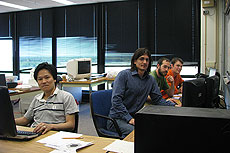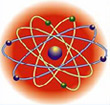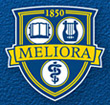|
Editor's note: This is the first of an ongoing series of profiles spotlighting the critical role of universities in particle physics research.

University of Rochester students Jaewon Park, Aaron Mislivec, Jesse Chvojka and Jermey Wolcott sit in the MINERvA control room.

NAME: University of Rochester
HOME TOWN: Rochester, New York
MASCOT: Yellow jacket
SCHOOL COLORS: Blue and yellow
PARTICLE PHYSICS COLLABORATIONS: MINERvA, CDF, DZero, Compact Muon Solenoid, Large Hadron Collider and LPC.
EXPERIMENTS AT FERMILAB: In addition to MINERvA, CDF and DZero, in the past, the University of Rochester has been involved in E706, NuTeV, CCFR and the development of the AZero photoinjector.
SCIENTISTS AND STUDENTS AT FERMILAB: 6 faculty, 11 postdocs and senior scientists and 10 graduate students.
COLLABORATING AT FERMILAB SINCE: 1972
MAJOR CONTRIBUTIONS: The proposal and development of detector technology and construction for parts of MINERvA, the construction of calorimeters for CDF and CMS, the construction of an outer silicon tracker for CMS, development of the DZero fiber tracker.
PARTICLE PHYSICS RESEARCH FOCUS: Neutrinos, dark matter, electroweak interactions, quarks, gravitational wave detection and non-linear quantum electrodynamics.
WHAT SETS PARTICLE PHYSICS AT THE UNIVERSITY OF ROCHESTER APART?: The University of Rochester is one of the smallest major research Universities in the country but has four theoretical and 10 experimental faculty focused on particle physics. "We are the mouse that roars."
FUNDING AGENCY: National Science Foundation and the Department of Energy
FAVORITE NATIONAL LABORATORY: Fermilab
 
|